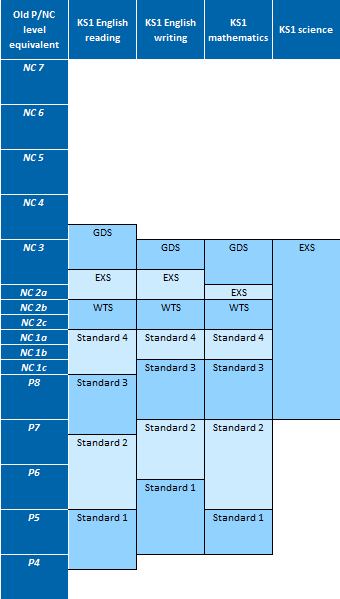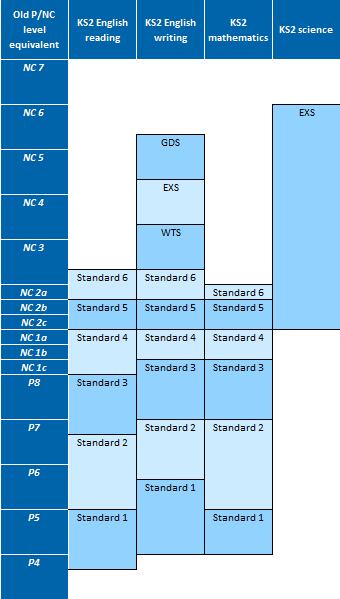The levels are dead…
In 2014, we were told that the National Curriculum level descriptors were bad. Possibly because teacher assessment was not as ‘accurate’ as testing. Possibly because the old level descriptor content didn’t match Gove’s new National Curriculum attainment targets. Possibly because a best-fit approach to assessment left ‘gaps’ in children’s learning. Possibly because parents and children didn’t understand them.
Four years on and The STA have finally published the ‘permanent and extended ’ pre-key stage standards; and at first glance they look very different to the last edition. What is particularly interesting is that they also look very different to the recommended standards that were published in the appendices of The Rochford Review: final report.
And yet, they still somehow look quite familiar: *cough* levels *cough*.
Review and revolution
Following the long-delayed final report of The Rochford Review and the subsequent open consultations, The STA sought advice and guidance from classroom staff and educational practitioners regarding the content of these suggested pre-key stage standards.
The pre-key standards are almost unrecognisable from the Rochford-recommended standards. I’m glad to see that the ‘experts’ hard work was worth the wait. And, whilst I have no real idea how much attention was paid to the responses garnered, the extent of the changes seem to indicate that a lot more thought and effort went in to the production of these new assessment standards. It makes me question why the STA didn’t go straight to the experienced grass-roots professionals in the first place.
But I still have a problem with the name! The pupils who will be assessed against these standards are not ‘pre-key stage’ learners.
Clear as mud
The STA state that the standards are provided for the statutory assessment of pupils who are in Year 2/6 and are engaged in subject-specific learning but who have not completed the programme of study, and are therefore working below the level of SATs.
They make it incredibly clear that: “The standards are not a formative assessment tool” and then immediately contradict this simple instruction by suggesting that:
The pre-key stage standards may also be useful for teachers to refer to for pupils of all ages, including those attending secondary school
Pre-Key Stage Standards (2018–19), p.2
So once again, we have been given mixed messages!
The useful bits
The STA spell out what it meant by their qualifiers and examples. This aspect of the guidance is actually quite useful. According to the document ‘most’ indicates that the statement is generally met with only occasional errors; ‘many’ indicates that the statement is met frequently but not yet consistently; and ‘some’ indicates that the skill/knowledge is starting to be acquired and is demonstrated correctly on occasion, but is not yet consistent or frequent.
The STA also state that reasonable adjustments should be made for pupils with disabilities and that the pupil’s individual method of communication or study can constitute as an acceptable substitution. Additionally, and in line with the recent adaptions to the English writing aspect of the teacher assessment framework, The STA points out that statements can be disapplied on the basis of a pupil’s physical disability.
However, this seems to be contradicted later in the notes on English writing, whereby The STA state that:
This approach applies to English writing only.
Pre-Key Stage Standards (2018–19), p.6
What’s changed?
Most noticeably, there is an extra standard in both the Key Stage 1 and Key Stage 2 frameworks. I believe that The STA have raised the skill-level required by pupils to achieve some of the lowest standards. This means that the pupils who may have just achieved an aspect of the proposed ‘entry to the expected standard’ descriptor (recommended in the Rochford Review) will now be assessed against P levels 1–4 currently, and whichever non-subject-specific criteria is decided upon after the Engagement Scale pilot. However, the ‘entry to the expected standard’ descriptor was huge—by our reckoning, it covered aspects of P levels 4–7. By raising the entry requirements in some areas, and introducing this extra standard, I believe The STA have balanced the new pre-key stage standards to create more evenly spaced attainment brackets.
For a more in-depth analysis of the changes click here.
Reading—a greater focus on understanding
The teacher assessment descriptors for pupils working at the level of the test have been removed in Key Stage two and there is a greater level of emphasis put on language comprehension.
Writing—creativity makes a comeback
There is a greater level of emphasis placed on the content and style of the pupil’s writing, not just the handwriting, spelling, punctuation, and grammar. This, alongside the fact that certain statements can be discounted for pupils with disabilities, means that there is less of a focus on the physical aspects of writing which previously seemed to discriminate against pupils with physical impairments or co-ordination issues.
Mathematics—less is more
The teacher assessment descriptors for pupils working at the level of the test have been removed in Key Stage two, much of the content has been removed from the higher levels and there is a greater emphasis is placed on arithmetic recall and mathematically reasoning.
Science—what science?
Despite the increased national focus on ‘STEM’ subjects, both the assessment frameworks for KS1 and KS2 science are almost entirely the identical to the previous iteration of the teacher assessment frameworks. They still only have a ‘working at the expected standard’ descriptor for each key stage and this means that the statutory assessment of science for pupils with working below these standards is not required.
Technically, a few sentences have been rearranged and The STA have helpfully identified in which school the content should be taught; but other than that, no big changes.
</palign=”right”>


…long live the levels!
Despite having it rammed down our throats that levels were bad and stifling children’s progress, it looks an awful lot like we’ve got them back.
The removal of the Key Stage 2 teacher assessment frameworks for English reading and mathematics, and the impending move away from end-of-KS1 assessments towards a reception baseline assessment may have alleviated the government’s distrust in teacher assessment, and allowed examinations to play a more solitary role in the assessment of mainstream pupils. However, they are still aware that this format will not work for around 20% of the school-age population, many of whom have SEND. I’m sure they’re not happy about that!
In the creation of the new pre-key stage standards, they have successfully updated the language of these new (not level) descriptors to match that of Gove’s National Curriculum. If you ask me, it seems like a lot of chaos, stress, and extra effort for very little reward, but at least Pob gets to put his name down in the history books.
The best-fit approach of recording pupil performance as and where it is demonstrated has all but gone. With such broad areas as English reading, this is a loss to all those pupils with spikey attainment profiles. I always remember two pupils I once taught. One child had severe dyslexic tendencies, she could barely distinguish the letters on the page, let alone recognise many words. However, when read to, she was able to use inference and deduction to explain how characters were feeling and predict upcoming events. The other student was statemented with autism. He could read words of inordinate complexity but very rarely comprehended their meaning. Because of the amalgamated nature English reading assessments, they were both recorded as operating at the same level but their capabilities couldn’t have been more different.
If we thought that parents didn’t understand levels, we’ve got another thing coming. How is Standard 3 any clearer than P8? It was reported that pupils felt bad because they had only progressed from a 2c in Year 2 to a level 4 in Year 6. Think how bad they’re going to feel when they are reported as working toward the standard in both key stages (or not achieving the standard as is the case in science).
However, I do think that these new frameworks are more balanced than the Rochford-recommended descriptors and the 2017–18 frameworks. With the English reading framework, I am happy that The STA have increased the focus on comprehension; and in writing, I am very pleased that there has been a move away from just the physical skills required to transcribe. Both of these elements open the framework up to children with a broader range of special educational needs and disabilities. However, with the government still fixated on the idea of a secure-fit approach (albeit slightly softened in English writing), many pupils will still be reported as working at a lower ability level than accurately reflects their individual assessment profile.
But the real questions are:
- Will this new framework allow schools to show accurate and meaningful progress over a key stage for those students operating within the pre-key stage standards?
- With the impending move away from end-of-KS1 assessments towards a reception baseline assessment, will pupils with SEND sit a test at the age of 4 too? And what will their results look like?
Current documents:
Pre-Key Stage 1 Standards (2018–19)
Pre-Key Stage 2 Standards (2018–19)
PreTeacher Assessment Framework for Key Stage 1 (2018–19)
PreTeacher Assessment Framework for Key Stage 2 (2018–19)
Previous documents:
The Rochford Review: Final Report (2016)
PreInterim Pre-Key Stage 1 Standards (2017–18)
PreInterim Pre-Key Stage 2 Standards (2017–18)
PreTeacher Assessment Framework for Key Stage 1 (2017–18)
PreTeacher Assessment Framework for Key Stage 2 (2017–18)
